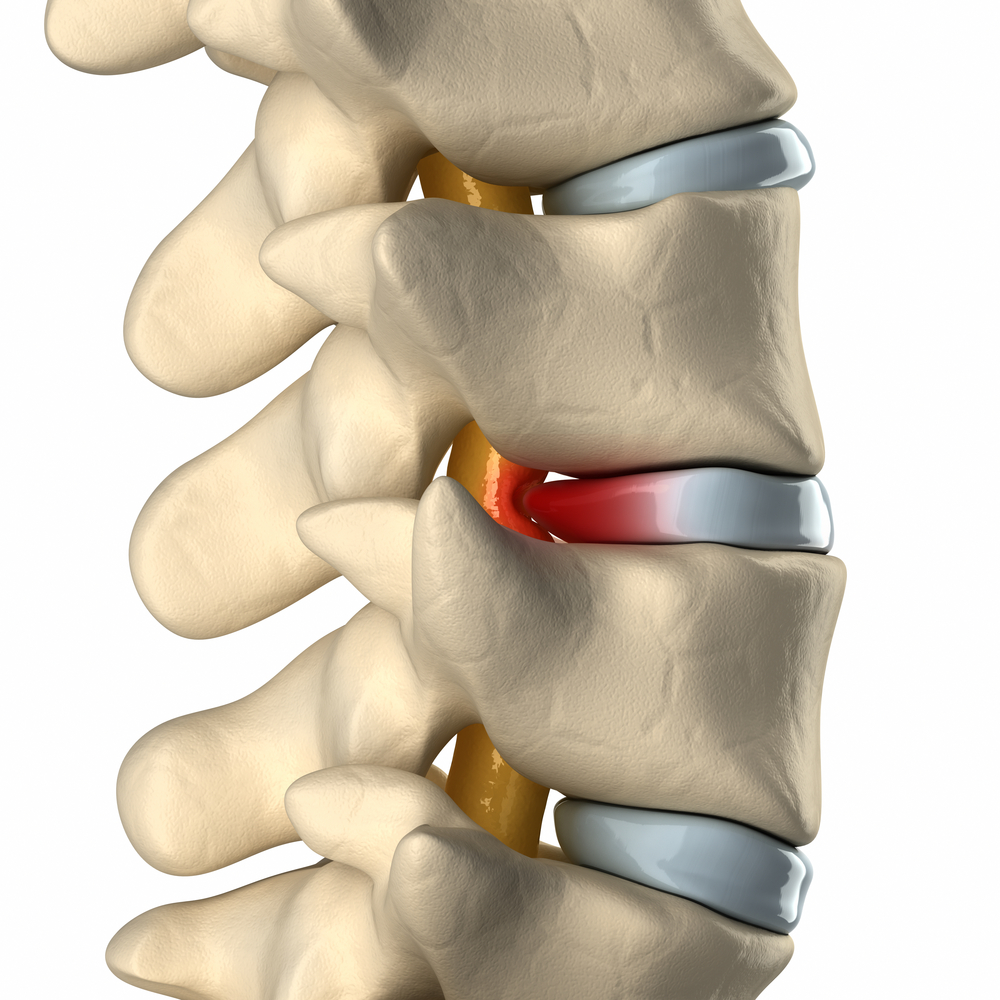A disc – in relation to your spine – is a rubbery “cushion” of sorts, with one disc occupying the space between each vertebrae, which are the individual bones that form your spine. These spinal discs are not unlike a jelly donut in that they have a tough exterior that encases a soft center. A disc becomes herniated when a crack occurs in its exterior which, in turn, allows for some of the softer, jelly-like interior, to push out – this is often times referred to as a “slipped disc” or a “ruptured disc”.
Herniated discs can irritate the nerves that branch off of the spine, causing pain, numbness, and weakness in the extremities. The majority of herniated discs occur in the lumbar region of the spine (lower back), although herniated discs can also occur in the cervical spine (neck). Some individuals can have a herniated disc and have not symptoms whatsoever – these types of herniations tend to be discovered via the imaging process for another injury or illness. However, many individuals with herniated discs experience pain that ranges from “mild” and “bothersome” to “excruciating” and “debilitating”.
What’s The Cause?
Herniated discs are often the result of nothing more than the aging process – this type of age-related “wear and tear” is referred to as disc degeneration. As we age, our spinal discs lose some of their water content, which makes them less flexible and more prone to tearing – or rupturing – with even a minor twist or strain. A large percentage of individuals aren’t able to pinpoint the exact cause of their herniated disc(s), however improper lifting (using your back as opposed to your legs) as well as twisting while lifting are certainly contributing factors. Sometimes, though, a traumatic injury – such as a blow to the back or a fall – can cause a disc to herniate. Factors that increase your risk would include: excess body weight, which creates extra stress on the discs; jobs which are physically demanding and/or require a lot of repetitive lifting, pushing, or pulling; and, genetics – some individuals are simply predisposed to the development of a herniated disc.
The Symptoms
Some of the most common signs and symptoms that occur with a herniated disc are:
Extremity Pain – A herniated disc in your lower back often results in pain the things, calves, and buttocks, and may also involve a portion of the foot. In contrast, a herniated disc in the cervical (neck) region will create pain the shoulders and arms, which can intensify with sudden movements or changes in position.
Numbness and/or Tingling – Individuals with a herniated disc often describe a numbness or tingling sensation in the area of the body that’s served by the affected nerves.
Weakness – This would include an inability to lift or hold items or stumbling, and is due to a weakening of the muscles that are served by the affected nerves.
It should be noted that your spinal cord does not extend into the lower portion of your spinal canal. Instead, the spinal cord separates into a group of long nerve roots – called the cauda equina (it looks somewhat like a horses tail) – just below waist level. Occasionally a herniated disc can compress the entirety of this structure, and emergent surgery may be required to avoid permanent weakness or paralysis.
If your pain travels down your leg(s) or arm(s), or is accompanied by numbness, tingling, or weakness, medical attention should be sought. If, however, your symptoms have worsened to the point of not being able to perform your usual activities, you are experiencing incontinence of your bladder or bowels, or are experiencing a phenomenon known as “saddle anesthesia” (a progressive loss of sensation of the areas that would touch a saddle) you should head to your nearest emergency room for evaluation.
How is This Condition Treated?
When it comes to treatment of a herniated disc, both non-surgical and surgical options exist. Examples of conservative (non-surgical) treatment would include items such as pain relieving medications and physical therapy. If, after an appropriate amount of time, non-surgical treatment is not able to provide adequate relief, surgical options may be explored.
Don’t Put Off Treatment
If you’re experiencing back pain, please don’t hesitate to give us a call! Nebraska Orthopaedic Center is able to provide comprehensive, multidisciplinary, state of the art treatment – when you combine that with our patient-centered focus, you can rest assured that our team of expert specialists will work together to determine an accurate diagnosis and create a customized treatment plan for you.
source: mayoclinic.com

